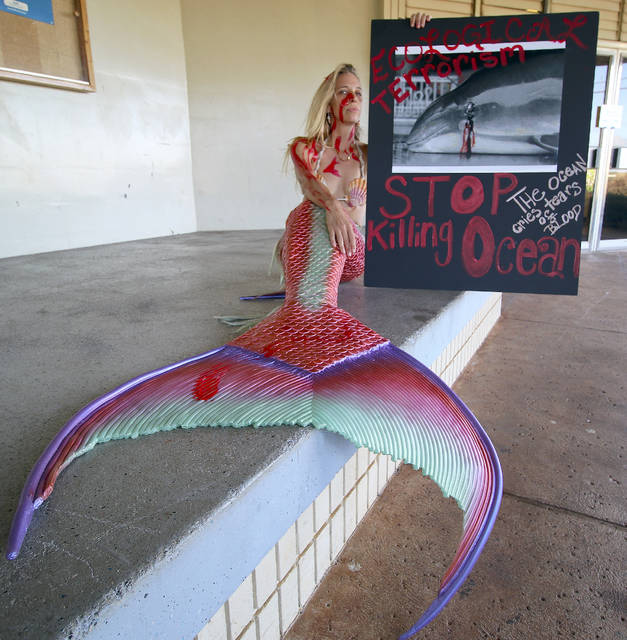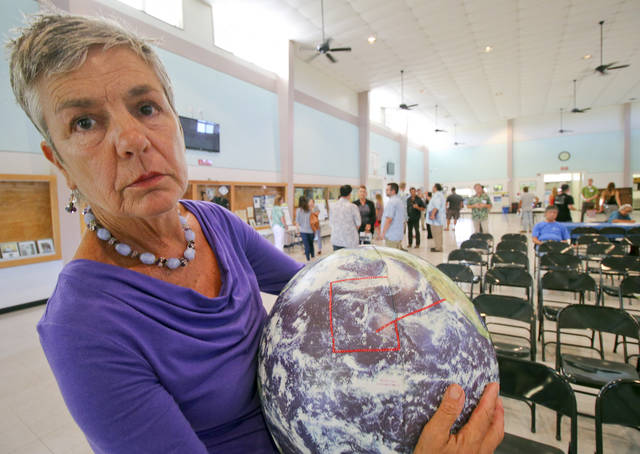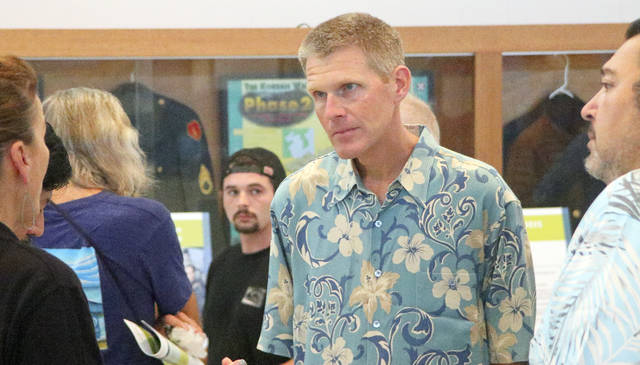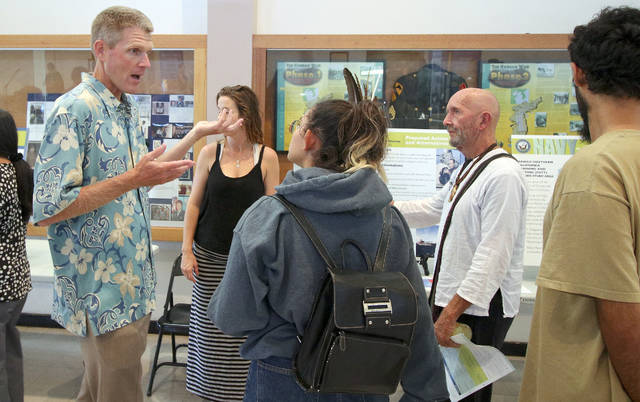LIHUE — Weapons and whales came head to head in Lihue Wednesday afternoon as the U.S. Navy presented its newest evaluation of the impacts training and testing activities have on the environment.
Live fire weapons testing, sonar, electromagnetic weapons, high-powered lasers, and unmanned aerial, surface and underwater vehicles — drones — are all on the list of proposed activities for the next five years.
“It’s more of a continuation of the same activities,” said Alex Stone, Hawaii-Southern California EIS (environmental impact statement) project manager for the U.S. Pacific Fleet.
He continued: “Meeting with the public is, of course, part of the process, but we are being transparent and reaching out to gather input.”
Mitigating impacts to marine mammals and other ocean life is a pride point for the Navy, Stone said.
An extensive list of those mitigations — like watchmen for sea life on testing ships — is included in the Navy’s new draft environmental impact statement/operational environmental impact statement for testing activities in the Hawaii-Southern California Training and Testing EIS/OEIS Study Area.
The document has been released to the public for comment until Dec. 12.
“We’re proud of being able to do our missions while protecting the environment,” said Capt. Vincent Johnson, commander at Pacific Missile Range Facility. “I firmly believe we can also be good stewards of our resources and the nation’s security.”
But many have concerns about the effects of military testing in Hawaii waters.
“I have been a resident here for 20 years and I’ve experienced changes. Some from the military,” said Ke’ala Lopez. “Once the EIS is figured, you’re going to continue testing and there are consequences.”
Lopez said she’d like to see more ways for the public to connect with the military and be part of the decision-making process.
“We need a way to allow transparency,” she said. “How do we make it work for both of us?”
About 50 people attended the meeting, along with six Kauai Police Department officers, at the Kauai Veterans Center.
Some showed up to voice their anger toward weapons and sonar testing in Hawaii waters and others coming to voice their support for PMRF on Kauai.
“There are good people in PMRF who are looking out for the environment,” said Mark Perriello, president of the Kauai Chamber of Commerce.
He pointed out that his current roommate is employed at the facility and said he is one of many who have a hand in environmental protection.
He continued: “My roommate’s job is to protect wildlife and PMRF is doing things to protect the environment. People need to know that.”
Protesting the Navy’s testing and training activities in Hawaiian waters was Mermaid Amber Ramsey, who attended the meeting in a mermaid tail with red paint smeared across her body.
“Papahanaoumokukea is a marine monument, there’s no point in having it if it is a place to destroy,” Ramsey said. “They’re going to leave humanity with no fish, and I don’t want to live in a world like that.”
The draft EIS/OEIS is required under the National Environmental Protection Act, and it’s not the first time the Navy has created the document.
The last one was accepted in 2013, and this draft EIS/OEIS takes much of its information from that document.
The Office of the Assistant Secretary of the Navy will review the draft EIS/OEIS after the nearly two-month comment period and Navy personnel expect a final decision in the fall of 2018.
After that, National Marine Fisheries Services is in control of issuing permits associated with Navy activity.
Island impact
Stone and Johnson both said it’s impossible to detail the frequency of the testing and activities expected over the next five years, but he said PMRF shouldn’t be experiencing much of a change in activity levels. Most weapons firing activities that involve the use of explosive munitions are conducted during daylight hours, according to the draft EIS/OEIS.
General procedures for sonic booms, high-powered lasers, and unmanned aerial, surface and subsurface vehicles are also outlined in the document.
Add your manao
Those who voiced their concerns and submitted comments to Navy staff members at Wednesday’s meeting are on record.
Those who still wish to submit comments on the draft EIS/OEIS can submit comments at www.HSTTEIS.com, or via mail to Naval Facilities Engineering Command Pacific Attention: HSTT EIS/OEIS Project Manager, 258 Makalapa Drive, Suite 100, Pearl Harbor, HI 96860-3134.
Comments must be postmarked or received online by Dec. 12 to be considered.








Whales and Dolphins are both sentient beings and sapient individuals. They deserve to have both their individual welfare protected and also for their moral and legal right recognized
Sentient animals may be aware of a range of emotions, sensations, of feeling pain and suffering and the experiencing a state of well being.
Sentient animals may be aware of their surroundings and what happens to them.
With Sonar Testing and underwater testing of explosives taking place right now from 2014-2019 in the Atlantic and Pacific Oceans including the Gulf of Mexico – this is an Acoustic Holocaust!
Last week there was an Indigenous Summit that convened here on Kauai with Elders from 13 Tribes from around the world. It was to hold ceremonies and talk story about the condition of the World. They are a part of the Wisdom Weavers Of the World Project. Of great concern to this group is the condition of our Earth.How do we come together and collectively shift back to living from our Hearts and living a sacred life?
The Ocean many forget, or they do no know because they do not live near the ocean, that they don’t experience the wonders below. The joyous, colorful, amazing creatures that live underwater…
The ocean needs to be recognized as a sacred place.
And let us not forget Plankton..It is the MOST vital organism on earth. Without Plankton the whole marine ecosystem will collapse.
We are heading for total destruction with the actions taking place underwater. this is not the way I want to go in moving forward…
Blessings to all
Josephine Bonaparte
I support more scientific research. Fund local resident marine biologists like Dr? Molly Lutcavage who has a long and storied research resume. In fact some of her research is sited in this most recent EIS that the navy has just presented. This region is data poor and needs more research. Just google her and find out what her life’s work has been about.
Sounds pretty terrifying. Must be another side to this story?